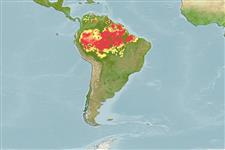Classification / Names
Common names from other countries
Main reference
Size / Weight / Age
Max length : 74.0 cm TL male/unsexed; (Ref. 40637); max. published weight: 6.8 kg (Ref. 40637)
Length at first maturity
Lm ?, range 32 - ? cm
Environment
Freshwater; brackish; benthopelagic; depth range 5 - ? m
Climate / Range
Tropical; 24°C - 27°C (Ref. 2060), preferred ?; 26°N - 9°S
Distribution
Short description
Diagnosis. Distinguished from all other species of Cichla except C. nigromaculata, C. intermedia, C. piquiti, and C. melaniae, by presence of bars 1a and 2a. Lateral band abbreviated in juveniles. Distinguished from its congeners with abbreviated lateral band by lateral line usually continuous (vs. discontinuous or nearly always discontinuous in orinocensis and nigromaculata; scales in E1 row (67-) 70-80 (-82) (vs. 84-93 in pleiozona); occipital bar absent or indistinct (vs. emphasized in adults of monoculus, kelberi, and pleiozona); abdominal blotches present (vs. absent in orinocensis); vertical bars present at adult size (vs. three midlateral ocellated blotches in orinocensis), except that an ocellated blotch consistently formed in dorsal portion of bar 3; absence of small black blotches on dorsum (vs. present in nigromaculata); vertical bars about equally wide across side (vs. wide, occasionally confluent dorsally, and tapering ventrad in nigromaculata, monoculus, kelberi, and pleiozona. Distinguished from C. intermedia, C. piquiti, and C. melaniae by abbreviated vs. complete juvenile lateral band, less scales in E1 row (67-82 vs. (78) 83-108), and presence of ocellated blotch in dorsal portion of bar 3 vs. absence (Ref. 57716).
IUCN Red List Status (Ref. 115185)
Threat to humans
Potential pest (Ref. 1739)
Human uses
Fisheries: minor commercial; aquaculture: commercial; gamefish: yes; aquarium: commercial
Tools
Special reports
Download XML
Internet sources
Estimates of some properties based on models
Phylogenetic diversity index
PD50 = 0.5000 many relatives (e.g. carps) 0.5 - 2.0 few relatives (e.g. lungfishes)
Trophic Level
4.5 ±0.80 se; Based on food items.
Resilience
High, minimum population doubling time less than 15 months (Assuming tm=1; multiple spawning per year; Fec=9,000-15,000)
Vulnerability
Moderate to high vulnerability (49 of 100)
Price category
